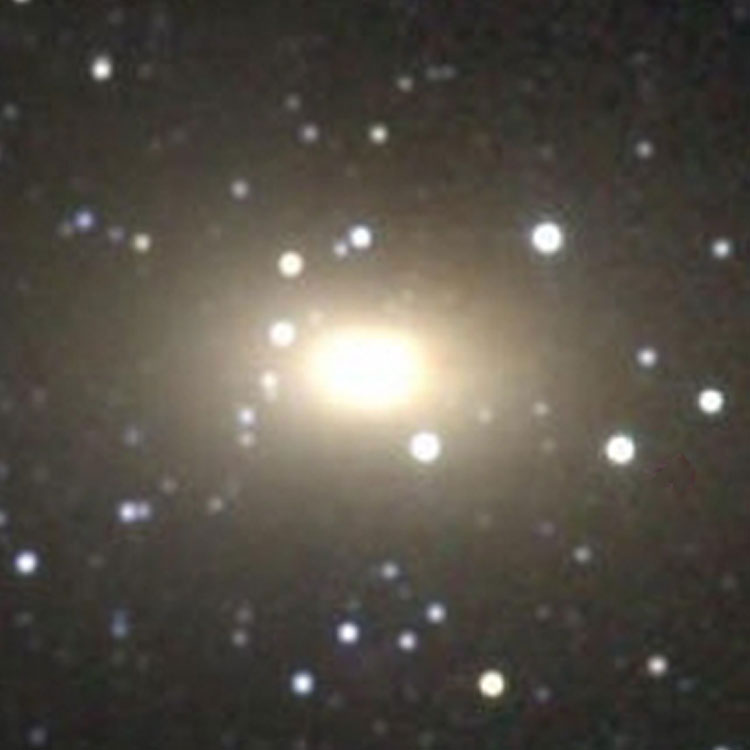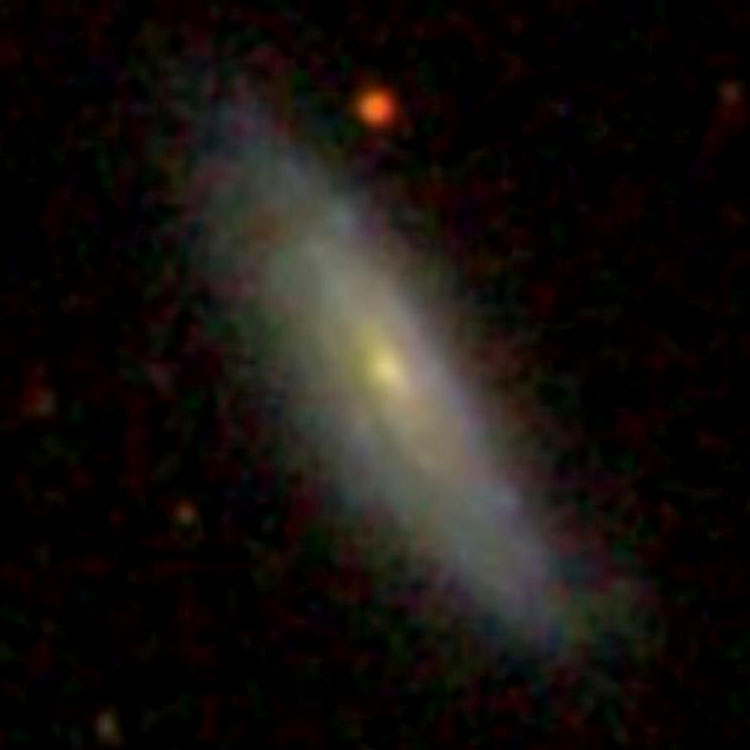Page last updated Oct 2, 2023 (Added note about Maffei Group to Maffei 1)
PGC 9892 (= Maffei 1)
(= UCGA 034)
A magnitude 17.8 lenticular galaxy (type E/S0? pec) in Cassiopeia (RA 02 36 35.5, Dec +59 39 16)
Nearly hidden by clouds of gas and dust in the plane of the Milky Way, PGC 9892 (also known as Maffei 1) is not far from our Local Group of galaxies, and as a result was once thought to be a distant member of that Group. However, aside from being in the opposite direction from the largest member of the Local Group (the Andromeda Galaxy), the galaxy is now known to be about 5 times further away. It and its nearby companion, PGC 10217, were discovered during an infrared survey of the so-called Zone of Avoidance (in which distant galaxies are rarely seen because of the gas and dust lying in the plane of our galaxy and obscuring anything beyond them) by Paolo Maffei in 1968, and as a result are often called Maffei 1 and 2. If it weren't obscured, and even its fainter outer regions could be seen in visible light, PGC 9892 would be over 70 times brighter, about magnitude 8.5, and relatively bright for a galaxy. As it is, it and its companion, which are now believed to be among the major members of the relatively nearby IC 342/Maffei Group of galaxies, are merely very faint reddish blobs when seen in visible light. It is only through infrared observations that their true appearance can be properly gauged.
PGC 9892's recessional velocity of -90 km/sec relative to the Costmic Microwave Backgroud is completely useless in estimating its Hubble expansion distance, as its "peculiar velocity" (its random motion relative to its neighbors) is obviously considerably greater than its Hubble Flow recessional velocity, and redshift-independent distance estimates aren't much more help, ranging from 7 to 14 million light years. However, as noted above, it and its companion are believed to be about five times the distance of the Andromeda Galaxy, or about 10 million light years away (presumably as an average or median of the distance estimates in the previous sentence), and if so, the galaxy's apparent size of about 3.0 by 1.8 arcmin (from the images below) would indicate that it is about 9 thousand light years across. However, that only refers to the size of its relatively bright central region, which is distinguished by considerable H II emission (and is probably the reason for its most common classification as E/S0? pec). Based on infrared observations it is thought that if we could see the entire structure it would be over 20 arcmin across, in which case the galaxy would actually be about 60 thousand light years across. If that is correct, it is the closest relatively large elliptical galaxy to our own galaxy.
Note About Common Wikisky Error: Wikisky searches for objects beginning with a "9" often truncate that digit; as a result, a search for PGC 9892 shows PGC 892, instead. So if using Wikisky to look for this galaxy, use Maffei 1 or its coordinates to search for the correct object.
Note About Classification: PGC 9892 is used by the de Vaucouleurs Atlas of Galaxies as an example of galaxy type E3, and if not for its exceptional ultraviolet luminosity, would almost certainly be classified as E3 pec. However, as noted above, most references list it as E/S0? (with or without "pec"), so that is what I have shown above, albeit with this paragraph to explain the disagreement about that classification.
Maffei Group: This galaxy is part of the Maffei Group of galaxies, which includes NGC 1560, NGC 1569, IC 342, and Maffei 1 and 2). 
Below, a 12 arcmin wide DSS image centered on PGC 9892 (= Maffei 1)
(If not obscured by the Milky Way, the galaxy would appear nearly twice as large as this field of view)
Below, a 3.6 arcmin wide DSS image of PGC 9892

Below, a natural-appearing infrared view of the same region (Image Credit 2 Micron All Sky Survey)

Below, a half degree wide DSS visible-light view showing Maffei 1 amd 2 (PGC 9892 and PGC 10217)

Below, a half degree wide infrared view showing Maffei 1 (PGC 9892) and Maffei 2 (PGC 10217)
(Image Credit NASA/JPL-Caltech/WISE Team)

PGC 9936
(= UGC 2106 = CGCG 388-065)
A magnitude 15(?) spiral galaxy (type Sb?) in (RA 02 37 24.2, Dec -01 49 18)
Physical Information: Based on a recessional velocity relative to the Cosmic Background Radiation of ? km/sec (and H0 = 70 km/sec/Mpc), a straightforward calculation indicates that PGC 9936 is about 390 million light-years away, in fairly reasonable agreement with redshift-independent distance estimates of about 325 to 335 million light-years. However, for objects at such distances we should take into account the expansion of the Universe during the time it took their light to reach us. Doing that shows that the galaxy was about 375 to 385 million light-years away at the time the light by which we see it was emitted, about 385 to 390 million years ago (the difference between the two numbers being due to the expansion of the intervening space during the light-travel time). Given that and its apparent size of about 0.9 by 0.25 arcmin (from the images below), the galaxy is about 95 to 100 thousand light-years across.
Note About Common Wikisky Error: Wikisky searches for objects beginning with a "9" often truncate that digit; as a result, a search for PGC 9936 shows PGC 36, instead. So if using Wikisky to look for this galaxy, use UGC 2106 or its coordinates to search for the correct object.

Above, a 12 arcmin wide SDSS image centered on PGC 9936
Below, a 0.9 arcmin wide SDSS image of the galaxy

PGC 9944
(= Markarian 369 = CGCG 462-036)
A magnitude 17.8(?) galaxy (type dE0? pec) in Aries (RA 02 37 28.3, Dec +21 08 31)
Physical Information: PGC 9944 is a galaxy with a very compact source of high-energy radiation, making it unusually bright in the ultraviolet (hence its classification as a Markarian galaxy), and as a side-effect of that, far brighter in the blue (B) band than than in the visual (V) band. In most cases, galaxies are two to three times brighter visually than in the B band, but Markarian 369 is 2.8 magnitudes (nearly 14 times) brighter in the B band than in the V band, or about 30 to 40 times brighter than usual. This makes its image very noticeably blue, and its classification includes "star-burst nucleus".
Based on a recessional velocity relative to the Cosmic Microwave Background radiation of 3845 km/sec (and H0 = 70 km/sec/Mpc), PGC 9944 is about 180 million light-years away. Given that and its apparent size of about 0.2 by 0.2 arcmin (from the images below), the galaxy is about 10 thousand light-years across, making it a dwarf galaxy, and even more unusual, since such exceptional nuclear activity is more often associated with larger galaxies.
Note About Common Wikisky Error: Wikisky searches for objects beginning with a "9" often truncate that digit; as a result, a search for PGC 9944 shows PGC 44, instead. So if using Wikisky to look for this galaxy, use Markarian 369 or its coordinates to search for the correct object.

Above, a 12 arcmin wide SDSS image centered on PGC 9944, also showing NGC 992
Below, a 0.5 arcmin wide SDSS image of PGC 9944 (= Markarian 369)

PGC 9962
(= PGC 127937 = ESO 115-021)
A magnitude 12.6 spiral galaxy (type SAB(s)m sp) in Horologium (RA 02 37 49.6, Dec -61 19 54)
Warning About Wikisky Search: The infamous Wikisky truncation error for leading 9's means that a search of that site for PGC 9962 returns an image of PGC 62, and using the ESO designation only returns an error message. As a result, the position must be used to do such a search.
Physical Information: Based on a recessional velocity relative to the Cosmic Microwave Background radiation of 445 km/sec (and H0 = 70 km/sec/Mpc), PGC 9962 is about 20 million light-years away, in exceptionally good agreement with redshift-independent distance estimates of about 15 to 25 million light-years, with a median estimate of about 19 million light-years. (For such a nearby galaxy, it is unusual to have such good agreement between the Hubble Flow and redshift-independent distances, as "peculiar velocities" (random motions relative to neighboring galaxies) are usually a substantial fraction of the observed recessional velocity in such cases.) Given that and its apparent size of about ? arcmin (from the images below), the galaxy is about ? thousand light-years across. *Better images need to be posted before the previous sentence can be completed.*
Note About Classification: The type is taken from the Spitzer Survey of Stellar Structure in Galaxies. The "sp" stands for "spindle", meaning that the galaxy is edge-on, making it harder than usual to determine its classification. One of the advantages of using infrared imaging by the Spitzer telescope is that it can see through most of the dust obscuring the central structure of the galaxy; if not for that, the classification would be far more uncertain. Earlier, visible-light classifications ranged from "cd" to "dm", primarily based on the size of the central bulge, but the infrared images suggest that a "later" type is more appropriate.

Above, a 12 arcmin wide DSS image centered on PGC 9962
PGC 9973 (almost certainly not = NGC 1037)
Not an NGC object but sometimes (almost certainly incorrectly) called NGC 1037
A magnitude 13.5 spiral galaxy (type SB(r)b?) in Cetus (RA 02 37 58.7, Dec -01 50 39)
Note About Common Wikisky Error: Wikisky searches for objects beginning with a "9" often truncate that digit; as a result, a search for PGC 9973 shows PGC 73, instead. So if using Wikisky to look for this galaxy, use its coordinates to search for the correct object.
Physical Information: Due to its misidentification as NGC 1037, see here for anything else about PGC 9973.
|